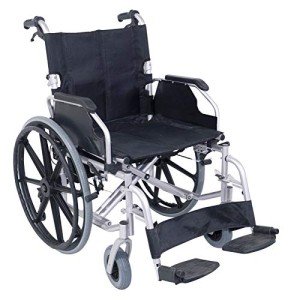You'll Never Guess This Bariatric Wheelchair 24 Inch Seat's Secrets
페이지 정보
작성자 : Elouise Ovens
조회수 : 7회
작성일 : 25-02-07 13:20
본문
 lightweight bariatric wheelchair Wheelchair Seat Width
lightweight bariatric wheelchair Wheelchair Seat WidthSeat Width
Having the proper seat width is necessary to wheelchair users who spend longer durations in their chairs. Too narrow a seat will cause pressure on the hips and thighs which might result in sores or pressure points. Having too wide a seat can also make it challenging for the user to reach the hand rims to move themselves or maneuver in little spaces.
To measure the right seat width a person would sit on a chair typically and have their measurement taken across their lap at the widest point which is typically their hips. A wheelchair measuring tape can be utilized to determine this, but a yard stick is chosen as it prevents individuals from covering the tape around their hips which would provide an incorrect outcome.
The basic wheelchair seat width is 16" (narrow adult), 18" (standard adult), and 20" (broad adult). For bariatric patients, a 24" seat is readily available. This durable extra large bariatric wheel chair wheelchair from Medline features swing-away footrests, bariatric wheelchair a carbon steel frame with rust- and chip-resistant chrome plating, and easy-to-clean vinyl upholstery. It has a weight capacity of 500 pounds.
Seat Depth
Generally, the seat depth of a bariatric wheelchair 400 lb capacity wheelchair was included 2" to the measurement taken at the user's best point (generally their hips). This was indicated to accommodate additional layers of clothing that may be used during cold weather condition. Nevertheless, this practice is ending up being less typical as wheelchair users have the ability to invest more time inside your home and are not using long coats. This makes the seat depth of a chair lesser when choosing a bariatric wheelchair. Nevertheless, it is still essential to select an alternative that uses adequate assistance for bigger users.
The Medline folding extra large bariatric wheelchair 400 lb capacity manual wheelchair features a comfortable 24" seat width and a durable slide tube silver vein frame. It likewise has an adjustable axle and tool-free elevating legrests.
Seat Height
When it comes to identifying the correct wheelchair seat width you ought to always determine from the user's largest point which is normally their hips. You will also require to consider whether the user is going to be wearing a winter season coat as this may add 2" to the width needed.
When a wheelchair remains in use it must only be run on level surfaces with the wheel locks totally engaged. This is to prevent the chair from having the ability to move slopes that are 10 degrees or greater. It is likewise essential to bear in mind that any activity that might shift the center of gravity in the chair should be finished with care. This consists of reaching for products that require the individual to lean out of their seat or attempting to stand from it.
Whenever you have the chair in usage it is recommended that you routinely check it for damage and lube any locations that are considered necessary. For instance, the casters ought to be oiled by removing the caster fork and utilizing a multi-purpose grease to apply to the caster stem bearings. Also, the foot plates can be adjusted by loosening the bolt and then moving them to the wanted position. This permits the feet to sit easily on the footplate and prevents any pressure points from forming. This can be extremely uncomfortable for the user and if left ignored, can cause pressure sores.
Weight Capacity
Bariatric wheelchairs are designed to support more weight than standard wheelchairs. This makes them sturdier and better equipped to deal with falls. They are also generally larger and broader, making them less maneuverable in tight spaces than basic wheelchairs. They need vehicles with special ramps and lifts to pack them, in addition to chauffeurs who understand how to finest transport them from one area to the next.
When selecting a wheelchair, consider its weight capacity as it will be the primary determining consider whether it will accommodate your guest's needs. The weight capacity of the chair is frequently noted as a fixed load, indicating that it shows the quantity of weight the chair can easily hold while stalling. Nevertheless, some producers likewise note an active load that is based on a drop test and can replicate the effect of someone sitting down in the chair. This may be a more reputable measurement of the weight limit, depending upon your requirements.
If you prepare to perform activities that shift your center of mass in the seat (such as grabbing items), make sure to have front casters pointed in a forward instructions and wheel locks engaged so the chair will not tip over. Also, check that casters are lubricated frequently to avoid excessive wear and abrasions. The lubrication treatment includes getting rid of the fork, separating the caster from the wheel, and greasing the caster stem bearings with top quality multi-purpose grease.